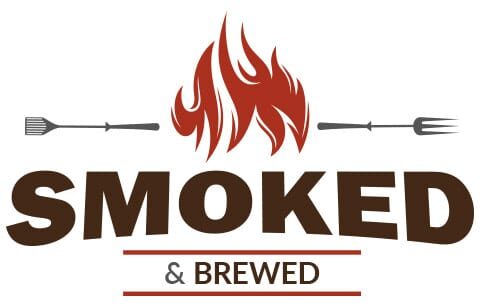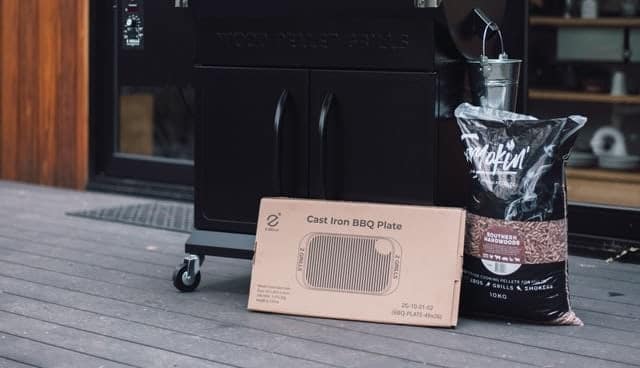You have finally purchased the smoker of your dreams: A mighty Pit Boss. This bad boy is going to get you smoking the manliest of meats to the most delicate of treats, but now you have to start thinking about what type of pellets you plan to feed it.
Can a Pit Boss use Traeger Pellets? Even though the brand names may cross, yes, a Pit Boss can use the pellets produced for a Traeger. The shape compared between the two is essentially the same and many of the same flavors are produced by both brands. There may be small differences, but nothing major enough to derail your smoking.
Even the most dedicated Pit Boss fan can find themself in a pickle and may have to swipe a bag of Traeger pellets. You may even find yourself curious as to whether or not the competing brand is better, worse, or just as competent. Continue reading to see how Pit Boss pellets and Traeger pellets compare to one another as well as the differences between grills and smokers.
Pit Boss vs. Traeger Grill Wood Pellets
It may seem unlikely that a product that looks almost identical could have any difference when it comes to two competing brands, however, Pit Boss and Taeger do in fact make their wood pellets a bit differently than one another.
This difference is not something that will ruin either grill if you use the opposite brand’s pellets, but knowledge is power and with this knowledge, you can decide which brand is more preferable to you personally as well as to your grill or smoker.
Pit Boss Wood Pellets
Pit Boss makes their hardwood pells from 100% all-natural hardwood. This hardwood is dried down to its core and then ground up into a super-fine sawdust. After it has been ground, the dust is pressurized at extreme heat which compacts the pellets.
To keep them held together, they are coated with the wood’s natural lignin. They have all kinds of different infusing flavors like Hickory, Maple, Pecan, and a handful of others.
Traeger Grill Wood Pellets
Traeger pellets are made from 100% hardwood and undergo the same process that Pit Boss’s pellets do. However, Traeger does use a flavor oil to help enhance the flavors their pellets are able to produce.
These oils are natural and are fine to have in and around your food, but the flavor they are able to produce is a bit different than how Pit Boss gets their flavor accomplished. Fortunately for you, you can typically use Traeger pellets in your Pit Boss, so interchanging between the two should be no big deal.
What are the Differences Between Traeger Grills and Pit Boss Smokers?
Even though you now know that a Pit Boss can use Traeger pellets, you might be wondering what the difference is between grills and smokers in the first place. With this, you can begin to understand how the complexities of the wood pellets you are using can affect the end result as well as the mechanical makeup of your machine.
Primarily, the difference between Traeger Grills and Pit Boss Smokers (and grills and smokers, in general) include the mechanical way they function, cooking temperature they reach, how long they require you to cook for, and the flavor produced.
Within these differences, you can understand how the wood pellet used would impact the machine (and the food you are cooking) directly. You want a high-quality wood pellet that will not become too ashy, one that will hold up if you were to apply much pressure, and one that can add the type of flavor that you are going for.
Let’s take a closer look at the difference between grills and smokers to more clearly understand how the wood pellets would (or would not) affect these.
Mechanical Differences in the way Grills vs. Smokers Function
A grill and a smoker may look about the same as far as appearances go but they operate quite differently. When you are grilling, you are using direct heat to rather quickly get your dishes from raw to cooked. When using a smoker, you are using indirect heat – the complete opposite. Let’s talk a bit more about what that looks like internally for your smoker and your grill.
For a grill, you are either going to use electric, charcoal, or gas to get things heated up. All of these come through points that are up close and personal to your food. The food sits above an open flame and is cooked quickly (compared to a smoker). With a grill, you have a lot of versatility about the types of food you are cooking, but it is not capable of grilling thick cuts of meat as the heat is too close and will end up scorching the outside without cooking the inside.
With a smoker, the use of indirect heat allows you the ability to smoke some seriously thick pieces of meat. A smoker will either be charcoal, gas, wood, or electric, but all cook at very slow rates with indirect heat by using either a water basin or a wood chip basin at the bottom of the smoker to heat at high levels without getting too close to your food. This allows you to cook slowly with a controlled temperature and also creates a smoky flavor that grills can’t achieve.
When comparing the wood pellets between the mechanical differences in grills and smokers, it is important to note the quality of the wood pellet. You will need one that can provide you with adequate heat in both temperature and timing. You should find that Traeger pellets can provide you with heat that is sufficient in both areas for your Pit Boss.
Cooking Temperature Variations
Now you understand how they are different and much of that has to do with the way things are heated up within a gas grill and smoker. Thus, we move on to temperature. In their very essence, grills are made to cook at high temperatures to get food cooked quickly and smokers are designed to cook food low and slow. Because of this, their temperature use is very different when cooking the same products.
For a grill, if you are wanting to fire up some burgers, you would likely crank the heat up and get those patties cooking so that you can have the perfect exterior with a nice pink interior. To do this, you likely would not keep your grill at a low temperature, it needs to be relatively high to ensure that the meat is cooked properly without totally overcooking the inside. Even if you did choose to cook something at a lower heat, a grill is going to get it done at a much faster rate.
However, for a smoker, you can cook your dishes as low as 160 degrees. Because of their goal to cook low and slow, the majority of users will likely cook at very low temperatures to make sure that their dishes are cooked through slowly so that they are tender and full of that smoky flavor.
Surprisingly though, smokers can be used at high heats to mimic more of a grilling feature in order to cook things like bacon or to braise meat. So, again, look at the specifications of the wood pellets that you intend to use to ensure that they are high-quality and meant for use with a high-quality Traeger grill or Pit Boss. Not all pellets are high-quality like these known brands,
How Long Grills vs. Smokers Cook
You already know that grills are built for speed and smokers are built to be paced. Outside of their temperature variances, they are very different when it comes to how long it takes them to get dishes from inedible to delectable. This is something you should weigh when considering one or the other: how much time do you see yourself investing in a meal and are you likely to prepare for a meal hours ahead of time?
When you are using a grill, you are cooking on direct heat. Because of this live flame in contact with your food, (it’s not as aggressive as it sounds) your dishes are going to cook more quickly than a smoker is capable of.
Even if you are cooking your food at a low heat, the item is still going to cook faster due to the direct flame that it sits above. Even if you have a large amount of food on the grill, it is capable of getting it cooked in a jiff.
Now, think of how a grill cooks and then think of the exact opposite, got it? That’s what a smoker does. The goal of smoking is to take your sweet time when it comes to getting your dishes to perfection. Nothing should be rushed and the lower and slower, the better. Smokers also do not require a lot of attention when it comes to checking on your food. You are able to leave things and forget them for hours on end until they have reached smoking perfection.
Flavors Produced by Grills vs. Smokers
You now know the differences between how these cooking machines get the job done, but there is one last thing to note: flavor. This may seem like something small to some of you, but when compared against each other, a grill and a smoker are going to come out with totally opposing tastes.
Ultimately, this becomes the biggest deal for you and your family. Now, depending on what you like, one may be more appealing to you than the other, but neither can be said to have the top spot. It all comes down to personal opinion.
With grilling, you are going to get a flavor that is more “hit and miss.” I don’t mean this in a negative way, but that the flavor will likely be dispersed intermittently depending on how your meat was set during the grill session.
Those grill marks on chicken pack a punch and add a nice variety with every bite when it comes to flavor variance. The taste will also be a bit more charred (not to a point of it being unwanted) than one that resembles smokiness.
With a smoker, the flavor is going to come out exactly as the name implies: smoky. When you are smoking, the food is completely surrounded by thick amounts of smoke that permeate your dishes.
Even more, that smoke can be flavored through the fire source that you use, like pellets. You can have pellets that are of a fruit tree variety, those that are more neutral like Maple and Alder, or pellets that are a bit more robust like Mesquite, Hickory, and Oak.
Scot has loved smoking food in his free time for the last few years. Each major holiday or off-weekend, Scot spends days testing and prepping new recipes for perfection.

